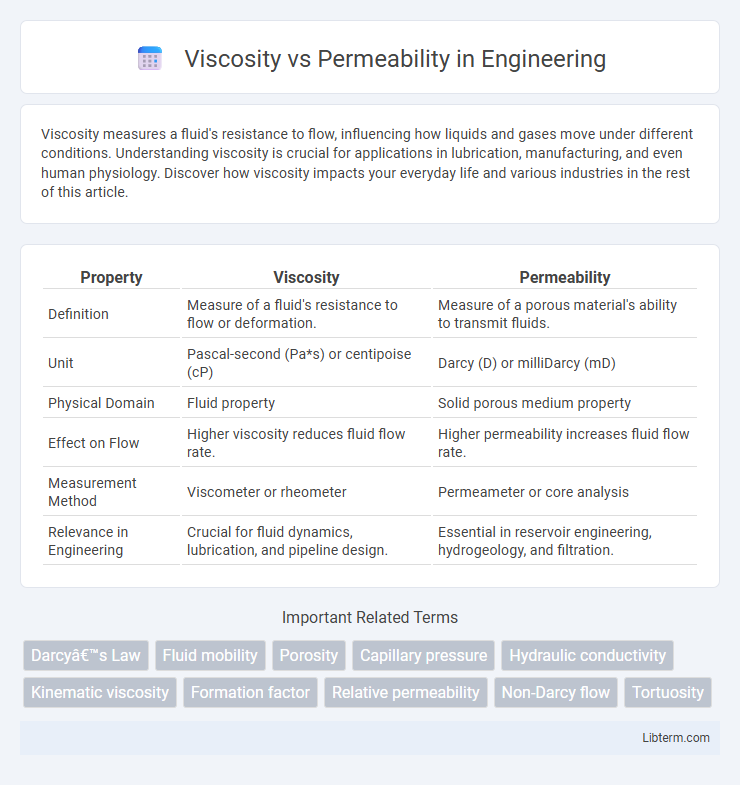Viscosity measures a fluid's resistance to flow, influencing how liquids and gases move under different conditions. Understanding viscosity is crucial for applications in lubrication, manufacturing, and even human physiology. Discover how viscosity impacts your everyday life and various industries in the rest of this article.
Table of Comparison
| Property | Viscosity | Permeability |
|---|---|---|
| Definition | Measure of a fluid's resistance to flow or deformation. | Measure of a porous material's ability to transmit fluids. |
| Unit | Pascal-second (Pa*s) or centipoise (cP) | Darcy (D) or milliDarcy (mD) |
| Physical Domain | Fluid property | Solid porous medium property |
| Effect on Flow | Higher viscosity reduces fluid flow rate. | Higher permeability increases fluid flow rate. |
| Measurement Method | Viscometer or rheometer | Permeameter or core analysis |
| Relevance in Engineering | Crucial for fluid dynamics, lubrication, and pipeline design. | Essential in reservoir engineering, hydrogeology, and filtration. |
Understanding Viscosity: Definition and Importance
Viscosity measures a fluid's resistance to flow, reflecting how internal friction affects its movement through a material. It is crucial in applications like oil recovery and chemical processing, where fluid behavior impacts efficiency. Understanding viscosity helps predict fluid dynamics, optimize pump design, and enhance permeability assessments in porous media.
Permeability Explained: Key Concepts and Applications
Permeability refers to the ability of a porous material, such as rock or soil, to allow fluids to pass through its interconnected pore spaces, measured in darcies or millidarcies. It is a critical factor in hydrogeology, petroleum engineering, and soil science for predicting fluid flow rates and reservoir productivity. Understanding permeability enables accurate simulation of fluid transport in reservoirs, enhancing extraction efficiency and groundwater management.
The Science Behind Viscosity and Permeability
Viscosity measures a fluid's resistance to flow, determined by the molecular interactions within the fluid, while permeability refers to a porous material's ability to allow fluids to pass through its interconnected pores. In fluid dynamics, viscosity influences the ease with which a fluid can move, whereas permeability depends on the structural properties of the medium, such as pore size, connectivity, and porosity. Together, these parameters critically impact fluid transport in geological formations, chemical engineering processes, and biomedical applications.
Factors Affecting Viscosity in Fluids
Viscosity in fluids is primarily influenced by temperature, pressure, and fluid composition, with higher temperatures generally decreasing viscosity due to reduced molecular cohesion, while increased pressure can either raise or lower viscosity depending on the fluid type. Molecular structure and intermolecular forces, such as hydrogen bonding in water or van der Waals forces in hydrocarbons, significantly affect the fluid's resistance to flow. Understanding these factors is essential in applications like petroleum engineering and chemical processing, where fluid dynamics directly impact permeability and overall system performance.
Variables Influencing Permeability in Materials
Permeability in materials is predominantly influenced by porosity, pore size distribution, and connectivity between pores, which dictate fluid flow pathways. The intrinsic properties of the material, such as grain size and compaction level, also significantly affect permeability by altering pore structure and resistance. Temperature and pressure conditions can modify these variables, leading to changes in permeability dependent on the physical state of the material.
Viscosity vs Permeability: Core Differences
Viscosity measures a fluid's resistance to flow, directly affecting how easily it moves through porous materials. Permeability quantifies a material's ability to transmit fluids, determined by the size and connectivity of its pores. The core difference lies in viscosity being a fluid property, while permeability is a characteristic of the rock or porous medium.
Measuring Viscosity: Common Methods and Tools
Measuring viscosity involves techniques such as capillary viscometers, rotational viscometers, and falling ball viscometers, each suited for different fluid types and viscosity ranges. Capillary viscometers measure the flow time of a liquid through a narrow tube, ideal for low-viscosity fluids, while rotational viscometers determine viscosity by assessing the torque required to rotate a spindle in the fluid. Falling ball viscometers calculate viscosity by timing the descent of a ball through the liquid, offering precise results for Newtonian fluids.
Techniques for Assessing Permeability
Permeability assessment techniques include core sample analysis, where fluid flow through rock samples measures intrinsic permeability under reservoir conditions, providing high-accuracy data. Well testing methods such as pressure transient analysis offer field-scale permeability evaluation by interpreting pressure response during controlled fluid injection or production. Nuclear Magnetic Resonance (NMR) and digital rock physics also improve permeability prediction by characterizing pore structure and fluid distribution non-destructively.
Real-World Examples: Viscosity vs Permeability in Industry
Viscosity significantly affects fluid flow in oil and gas extraction, where high-viscosity crude oil requires enhanced recovery methods to overcome resistance, while permeability determines how easily fluids move through rock formations. In groundwater management, low-viscosity water flows swiftly through highly permeable aquifers, enabling efficient extraction and recharge, whereas heavy contaminants with higher viscosity face slower migration. The paper and food industries rely on controlling viscosity for processing fluids like pulp or syrups, but the permeability of filtration membranes dictates the separation efficiency and product quality.
The Interplay of Viscosity and Permeability in Engineering
Viscosity and permeability critically influence fluid flow in engineering, where viscosity measures a fluid's resistance to deformation and permeability indicates the ability of a material to transmit fluids. High viscosity fluids reduce flow rates in porous media with low permeability, demanding careful design in applications such as oil recovery and filtration systems. Optimizing engineering processes involves balancing viscosity and permeability to enhance efficiency in fluid transport and reservoir management.
Viscosity Infographic

 libterm.com
libterm.com